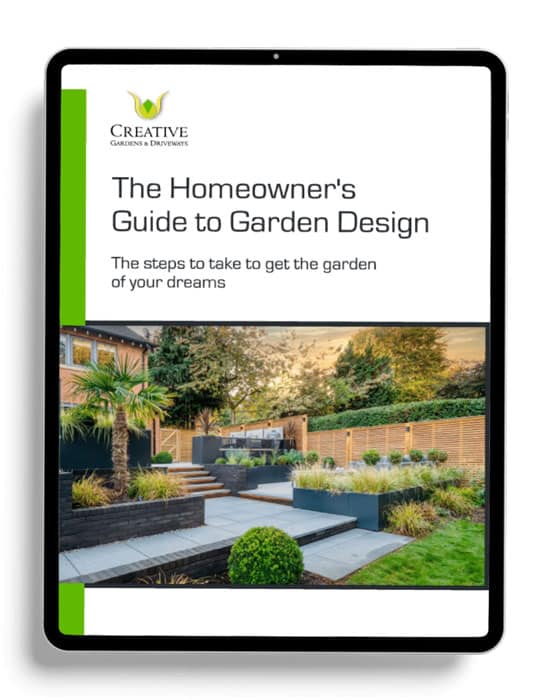Top Tips For Low-Maintenance Cheshire Gardens
Low-maintenance gardens are becoming increasingly popular across Cheshire and the UK in general, as it can be a great way to free up time.
Low-maintenance gardens are specifically designed to reduce the need for gardening tasks such as lawn mowing, aerating, fertilising, and planting. Instead, they are simple and modern outdoor spaces that look great all year round due to their reliance on durable materials and hardy plants.
As a local garden design and landscaping company, Creative Gardens & Driveways has seen an increase in demand for low-maintenance Cheshire gardens over the years. We understand what homeowners want and how to create a beautiful outdoor space without needing constant care.
Using this experience, we are sharing some of our best tips for low-maintenance Cheshire gardens so you can create your own and have more fun outdoors this season.
How To Design Low-Maintenance Cheshire Gardens: 5 Top Tips
Over the years, we have helped many Cheshire homeowners create the outdoor space of their dreams. We have seen the ongoing trend of low-maintenance gardens take over the region and understand what it takes to design a landscape that is beautiful, functional and simple.
Through a combination of beauty and practicality, you can create a low-maintenance landscape that gives you more time to enjoy the outdoors as opposed to working on it. These are our best tips for low-maintenance Cheshire gardens, which have been specifically designed for local climates and conditions:
1) Smart Garden Layout For Low-Maintenance Spaces
The best place to start when it comes to designing low-maintenance Cheshire gardens is the layout. Low-maintenance gardens should look great in all seasons and from all angles, to limit the work needed for upkeep. This is why simple layouts and garden designs are so beneficial for those seeking a low-maintenance Cheshire garden, and should be your first priority.
Creating a simple garden design means focusing on a limited number of features, including fewer plants, shrubs, and focal points. For low-maintenance gardens, less is more.
Limiting the number of plants and lawn areas not only keeps the design simple but also reduces the amount of gardening required to keep your space in prime condition. Natural elements, like real turf and plants, are time-consuming tasks, which is why many homeowners cannot keep their gardens looking good. By reducing the size and number of these spaces, you are also reducing the amount of maintenance needed in your garden throughout the year, without compromising visual appeal.
Instead of relying solely on natural elements, consider hardscaping alternatives such as porcelain patios and block paving pathways. These can create zones and flow in your garden design, but do not have the same maintenance demands as growing plants and grass, making them ideal for low-maintenance Cheshire gardens.
2) Choose The Best Plants For Less Work
As we have mentioned, the majority of work in your garden comes from the ongoing needs of natural elements and plants. By reducing these areas or carefully choosing your options, you can still have a thriving garden without having to sacrifice time to working on it.
Some of the best plants for low-maintenance Cheshire gardens are drought-resistant species, such as lavender, sedum, and ornamental grasses. These can be used to create unique displays of colour and texture across the landscape, but do not need watering as frequently as many other plants. These plants and shrubs are acclimated to dry conditions and can thrive in all seasons, ensuring your low-maintenance garden looks good all year round.
Another great option for low-maintenance Cheshire gardens is native plants, which thrive in the local climate and conditions, and perennials, which come back every year. By choosing plants that can thrive on their own and come back each season, you can ensure your garden looks great without the additional effort.
When organising your low-maintenance garden, it is recommended to group plants based on their maintenance needs. For example, grouping all drought-resistant plants in the same container or area of the garden will make it easier to prioritise watering and get the task done quicker.
3) Replace Lawns With Hardscaping
Similarly to reducing planting areas, you can drastically decrease the need for garden maintenance by replacing the lawn. Many low-maintenance Cheshire gardens have forgone lawns altogether and used the main surface area of their landscapes as patios or decking.
Replacing the lawn reduces the need for time-consuming tasks such as mowing, aerating, and fertilising, which continue throughout the year. Keeping grass healthy and attractive is an ongoing task, and one that a lot of homeowners in the region cannot afford, which is why replacing this area is very beneficial.
Alternatively, if you still desire to have some lawn space, for example, for children or simply to soften the design of your landscape, you can either rely on artificial grass or reduce the space slightly. By using artificial grass, you can still have the same appearance of a lawn without needing to care for it. Reducing the space, by incorporating patios, wider pathways or decking, allows you to add more structure to the garden without completely sacrificing the traditional grass appeal.
4) Suppress Weeds With Mulch
Weeds are every gardener’s nightmare and can take a lot of effort to get rid of, which is why prevention is a key part of low-maintenance Cheshire gardens. Mulching is one of the most effective ways to suppress weeds, and it is incredibly easy to implement, making it ideal for low-maintenance gardens.
A layer of organic mulch, such as compost, wood chips or manure, will help suppress weeds and should be applied to all planting areas across your low-maintenance garden. Not only does mulch help with weed suppression and control, but it also offers additional benefits to your plants.
Organic mulch can also provide essential nutrients to your plants and flower beds as it decomposes. The layer of mulch over root systems helps to maintain both soil temperature and moisture, reducing the need for constant watering and care. With organic mulch, many of the gardening tasks required to keep plants healthy happen naturally, allowing you to enjoy the benefits of a well-cared-for garden without having to lift a finger.
To ensure the best benefits from mulch, ensure an even layer is set over soil and root systems, but no mulch touches the stems or trunks of plants.
5) Rely On Hard-Wearing Materials
Whether you intend to replace all soft landscaping with paving or simply want to create multiple zones in your low-maintenance garden design, material choice matters. Hardscaping can be a staple of low-maintenance Cheshire gardens, as long as they are made from all-weather, durable materials.
For example, instead of relying on traditional timber decking, composite decks are a great alternative and can be more low-maintenance. Composite is a synthetic material that can have the same appearance and texture as wood, but does not require the ongoing treatment you’d expect. Decking can be a great way to reduce lawn space and level out your garden, but it is important to remember that wood needs to be treated at least annually to keep it attractive and weather-resistant.
Patios and pathways are another staple of low-maintenance gardens, and are best installed in hard-wearing solutions like porcelain, resin and even gravel. Natural stone and block paving can also be a great way to add traditional appeal to a low-maintenance garden, but may require additional treatments to keep in prime condition.
Resin is a permeable surface that is often used for driveways, but can be used for patios and pathways and is renowned for its long-lasting, low-maintenance nature. Porcelain paving is a recent favourite for many Cheshire homeowners as it has a modern appearance and is extremely hard-wearing, making it a worthwhile investment for your outdoor space.
By carefully considering the materials used across your garden, you can reduce the need for maintenance, treatment, and repairs without compromising visual appeal.
Conclusion
Low-maintenance Cheshire gardens are designed to reduce the need for constant upkeep without compromising appearance. This is ideal for many homeowners across the region, as it frees up time in your schedule and allows you to enjoy more hours in the sun with friends and family.
There are various ways you can reduce the maintenance needed outdoors, such as through durable hardscaping, native planting, and careful layouts. Working with professional landscapers, like Creative Gardens & Driveways, gives you access to a range of services and expert advice so you can create the ideal garden for your needs.
Contact Us Today
Are you looking to design a low-maintenance garden? Our team is here to help, and we look forward to working with you. Reach out today to get started or to learn more.
FAQs
What are the best low-maintenance plants and flowers for Cheshire gardens?
Drought-tolerant perennials like lavender, sedum, and ornamental grasses thrive in Cheshire’s climate with minimal care, making them an ideal solution for your low-maintenance garden. Alternatively, evergreen shrubs such as boxwood are a great solution for low-maintenance gardens as they provide year-round structure without pruning.
How can I reduce the time spent mowing and weeding in my garden?
A great way to reduce time on weeding and mowing is to replace your lawn with hardscaping such as gravel or a large paved patio. Weeding can be reduced through mulching, which not only prevents weeds from growing, but also maintains soil moisture and conditions to support plant growth organically.
Are irrigation systems worth it for a low-maintenance garden?
Yes – an automated drip irrigation system can be a great tool for your low-maintenance garden as it ensures consistent watering directly to plant roots without any additional work from you.




















